Arsenal endured a slow and sterile first half away at Aston Villa on Sunday evening. Even if it was a little baffling that Villa were able to take the lead with their only effort on goal of the entire game, it wasn’t so much that the Gunners were 1-0 down at half-time, it was that they were not moving Aston Villa’s 532 formation around more.
Arseblog News asked Eidevall what he changed at half-time and, as well as asking his team to be more proactive in the press, he explained that he wanted his team to switch the play more often and move Villa’s low defensive block around.
‘It was really important to attack on one side with a structure and start dragging their 10s out on that side and then, with speed and determination, go over on the other side. That was where we would open them up.’ Arsenal undoubtedly also played with greater intent and hit their passes with greater urgency. Switching the point of attack wasn’t the only way Arsenal hurt Villa in the second half, but let’s look at some examples of this aspect.

Let’s start with the first half. Arsenal were too happy to play into central areas where Villa could easily crowd them out in the first half. McCabe has the ball here and you can see that Pelova is a sensible pass because she is in space.

Pelova tries to play the through ball to Russo and, again, you can see why. If she makes it Russo could be through on goal and Arsenal have generally been too cautious about playing high value passes that might not come off this season. But the pass is blocked by Patten because Villa are clogging up central areas. You can see Mead might have been the better pass here because she is in more space.

Arsenal win the ball back and Fox tries to find Russo centrally here but you can see how congested that central space is. Both wingers are slightly in-field as is right-back Emily Fox.

Fox tries to feed Russo, who is crowded out. Arsenal were too quick to go into these crowded areas in the first half.

We see something similar here as Wubben-Moy builds from the back. Again, you can see that Villa have clogged up the centre of the pitch.

Wubben-Moy tries a pass into Russo but Jordan Nobbs is well positioned to intercept it and protect the Villa back five. There was a lack of space in these areas.

Something similar happens again as Fox tucks the ball back to Williamson. Arsenal’s build-up was also too ponderous in the first half.

Williamson tries to find Maanum centrally but, again, it’s too congested and Nobbs makes another interception. Villa’s injury crisis meant they played a midfield three of Daly, Nobbs and Dali, which features three very attack minded players. Arsenal didn’t do enough to make them uncomfortable in their defensive roles in the first half.

By now, Arsenal are a goal down as Wubben-Moy brings the ball forwards and surveys her options.


The pass finds Russo but, again, this is a very crowded area and it’s difficult for Russo to do anything with the ball here. Villa crowd her out and scramble the ball away.

However, as Arsenal collect that clearance and attack again, they do decide to spread the play and Williamson, instead of playing into traffic, hits a cross field pass to Lacasse over on the left.
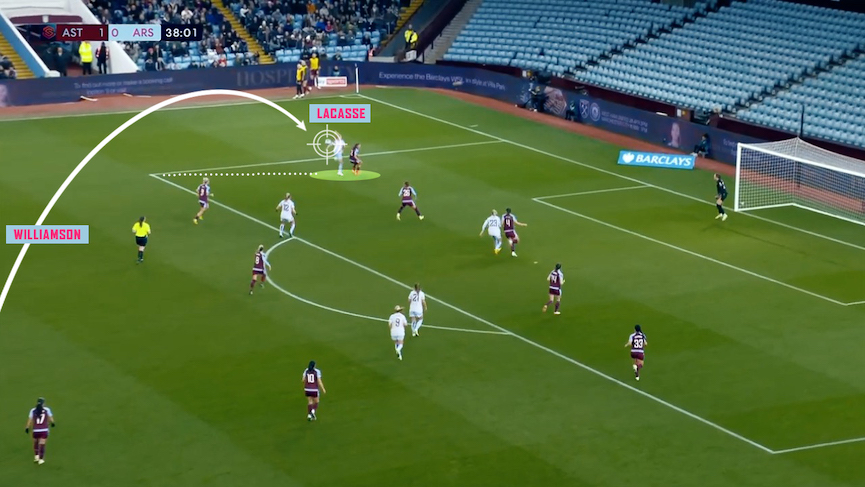
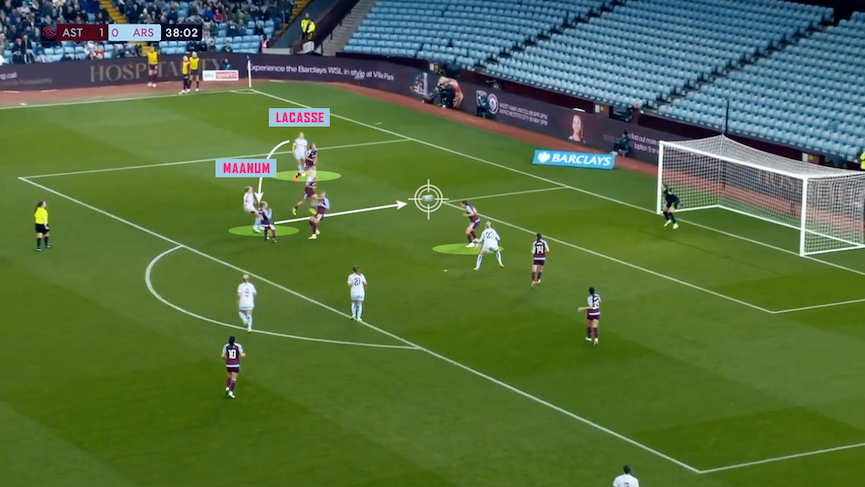
Lacasse is able to cushion the ball back to Maanum first time and her shot is deflected just over. It was one of the best openings Arsenal created in the half and it came from switching the play.
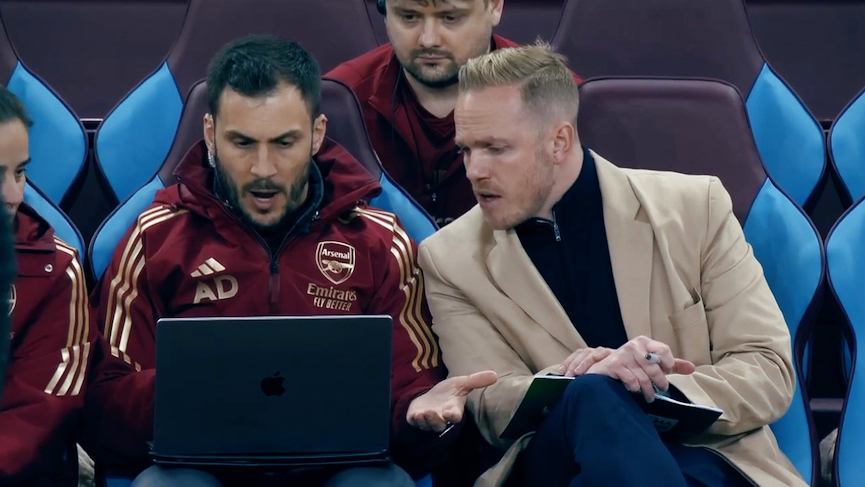
As the half-time whistle blew, Eidevall and his assistants Aaron D’Antino and Renee Slegers, with analyst Johnny Dixon behind them, do not go straight to the dressing room and decide to bide their time and look at some first half footage.
SECOND HALF

Straight away in the second half we see much more of an emphasis on ‘swinging’ the ball from side to side and moving Villa’s defensive block around. Little collects the ball here.
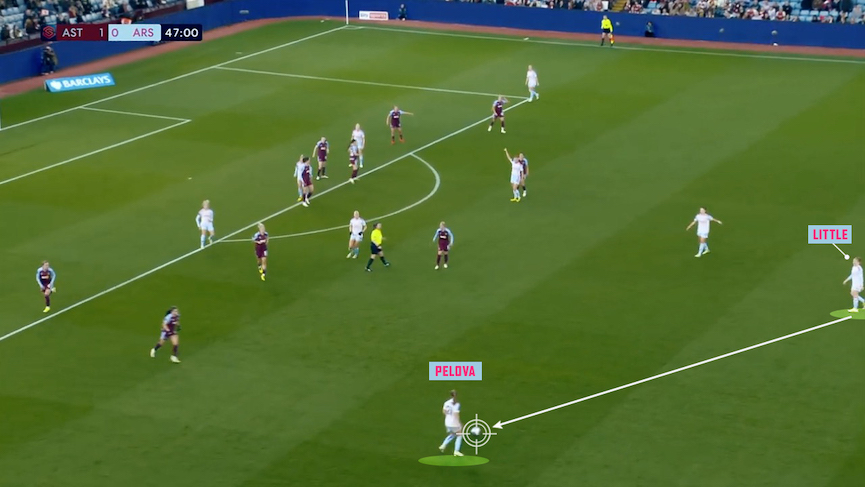
And she finds Pelova, who has pulled to the corner of the 18-yard area. This is an area Arsenal found several times in the second half on the corner of the area. You might remember Beth Mead’s goal against Everton in January, which saw Lia Walti cross the ball to the back post from this zone.
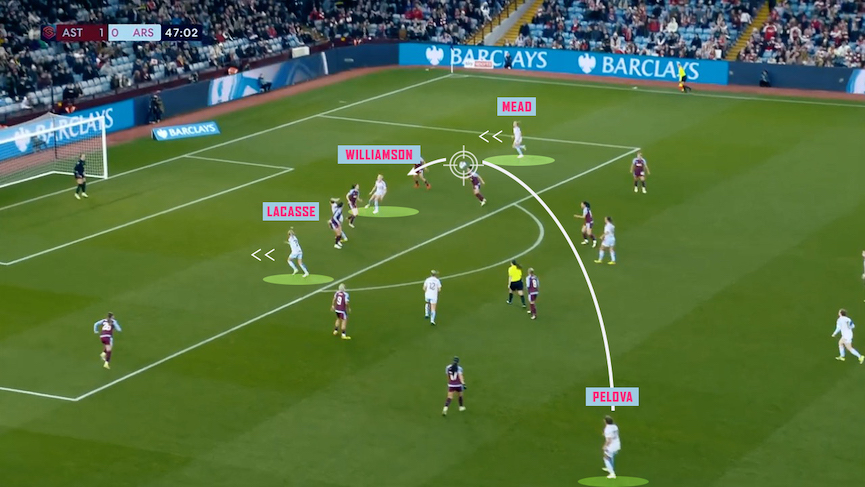
Williamson wins the header and it finds Mead on the back post, who cuts the ball into a dangerous area but Villa scramble clear. Arsenal stretched their opponents far more and made them move around.
The composure from Pelova!
Placing her shot after being first to the rebound! 🙌#BarclaysWSL @ArsenalWFC pic.twitter.com/uMSOSNEhWy
— Barclays Women’s Super League (@BarclaysWSL) March 24, 2024
One of the other areas Eidevall identified as an area for improvement at half-time was Arsenal’s intent to press. I am not highlighting examples of that in this piece for the sake of brevity but we see it perfectly illustrated in the equaliser, as the Gunners force a high turnover for Pelova to score.
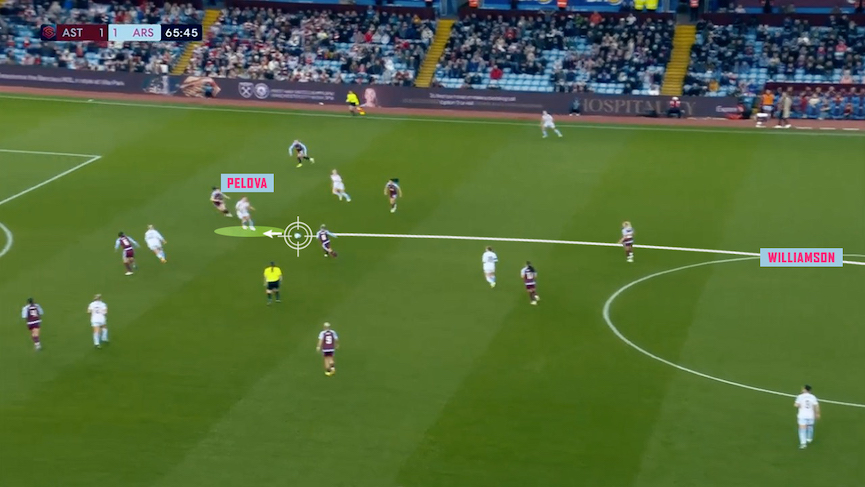
Williamson punches a superb pass between the lines into Pelova here.
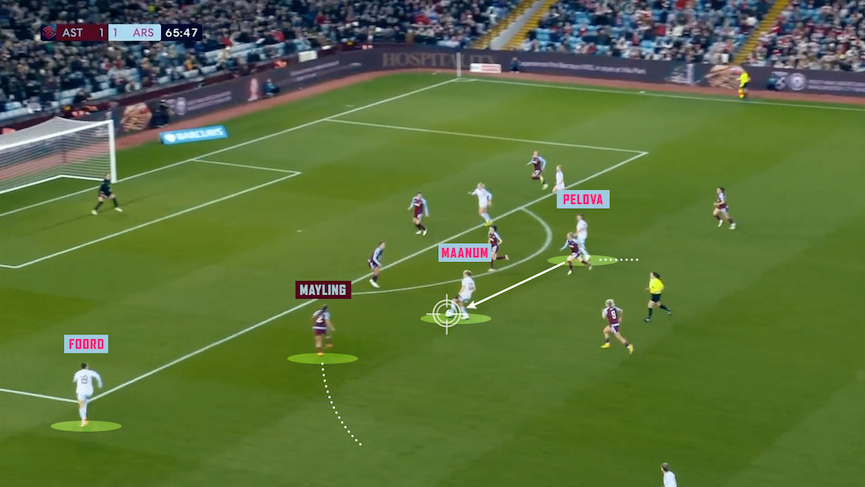
Pelova drives inside and finds Maanum. Look at Sarah Mayling, the right-back, she is being sucked over towards the ball, leaving Foord free on the left.

Maanum finds Foord on the overlap whose cross is cleared. But by quickly moving the ball from side to side, Arsenal were able to commit Villa defenders out of their shape and create space.
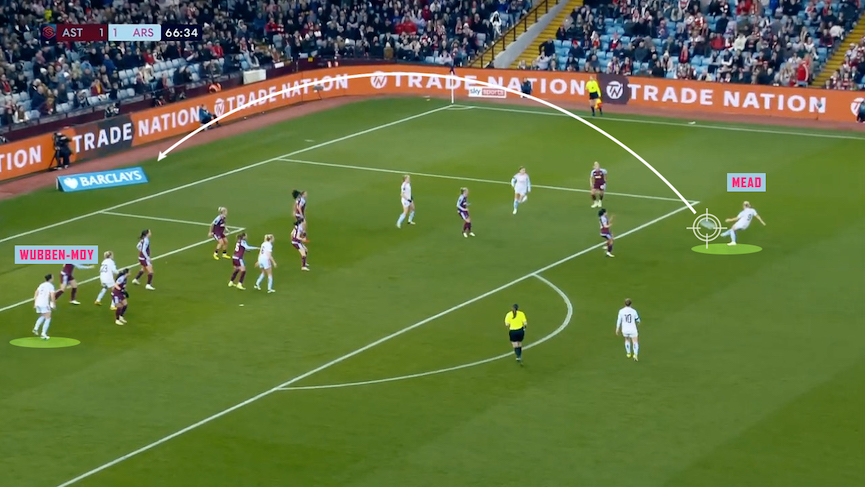
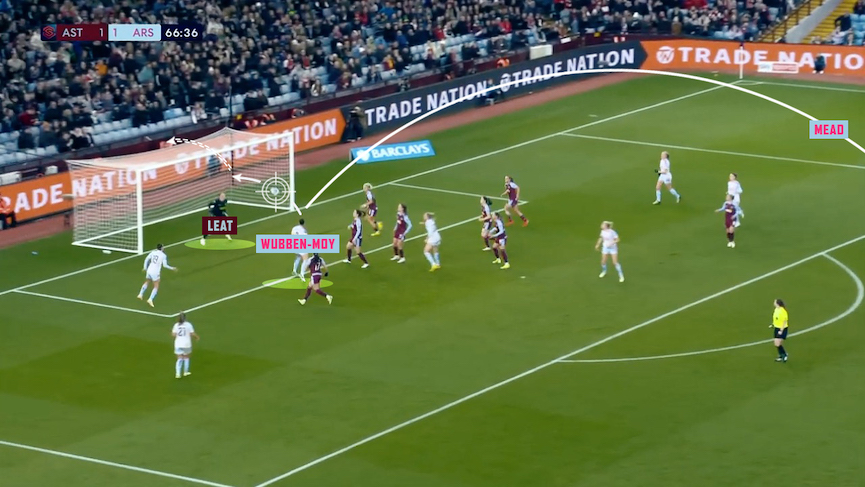
Here is another example of Arsenal finding a crossing opportunity from ‘the assist zone’ on the corner of the area. Villa clear a corner, it drops to Mead from the corner of the area and her cross finds Wubben-Moy unmarked on the back post which Leat tips over. Arsenal went from corner of the area to back post several times in the second half.
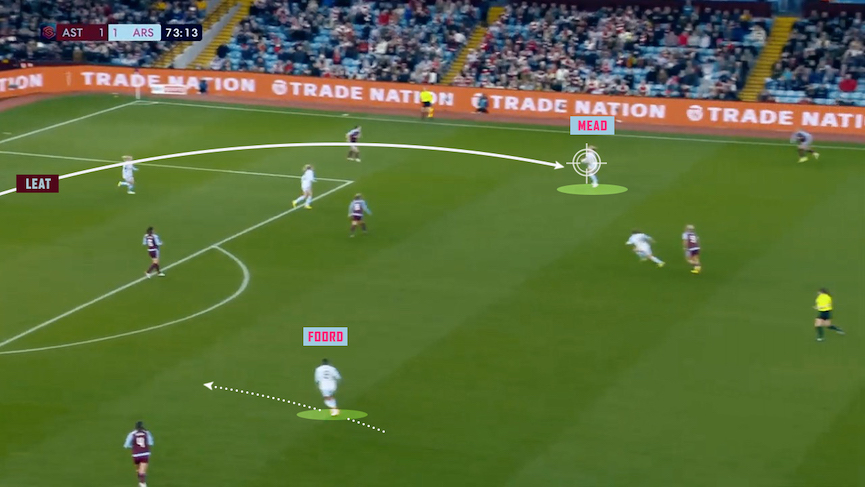
Here, we see an example of more intensive pressing and a desire to switch play quickly. Leat’s clearance falls straight to Beth Mead who controls. Caitlin Foord can immediately see space to run into on the back post.

Mead takes one touch and hooks the ball to the back post to find Foord’s run and Leat is once again forced into a fine save from close range. Again, Arsenal went from corner of the area to back post and switched play quickly in this example.
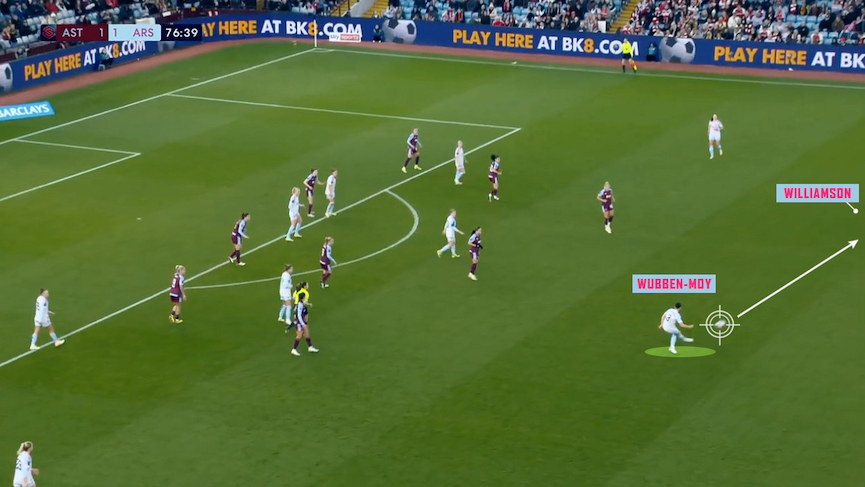
In this example, Arsenal get another cross from that ‘assist zone’ on the corner of the area. Wubben-Moy swings the ball out wide to Williamson.

Williamson gives it straight back to her. This is designed to make the Villa defence move from side to side and become more physically and mentally tired. On the latter point, we see that Russo has been able to creep over to the left unnoticed.
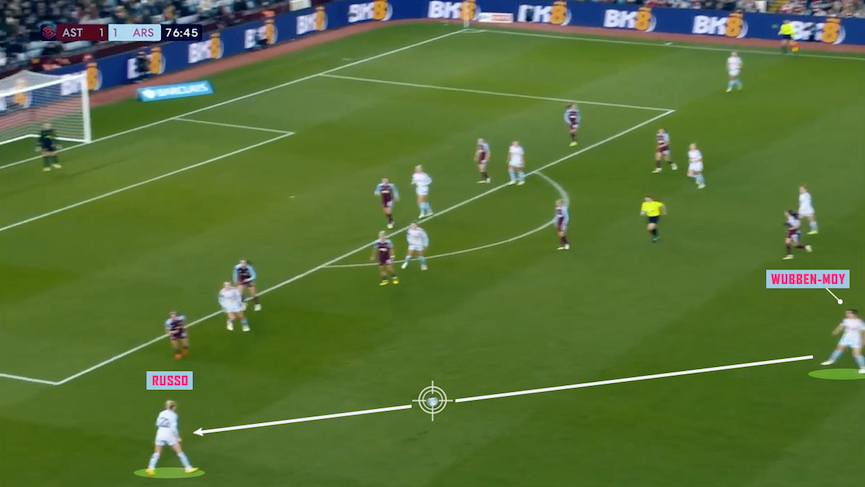

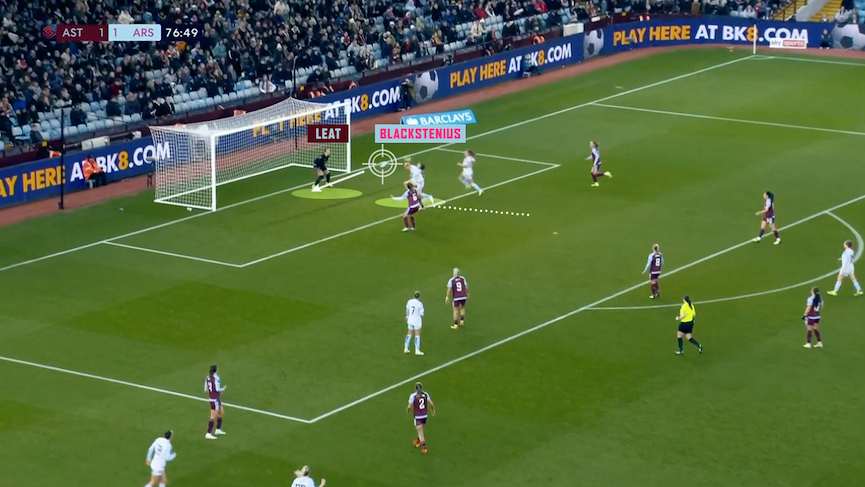
Wubben-Moy finds her, Russo has the time to collect the pass, look up and swing an excellent cross to the back post which Blackstenius heads straight at Leat.

The ‘assist zone’ cross finally pays off on 83 minutes. Villa clearly a corner and Fox collects the clearance. Compare the image of Villa’s defence, calmly strung along the whole penalty area in the first half compared to now. They are physically and mentally fading having been moved around so much. Russo again tiptoes away from the area to the left edge of the penalty area.


Exactly the same as the previous example, Russo has time to set herself, pick out a cross to the back post and Wubben-Moy is on hand to head the ball home to finally give Arsenal a deserved lead. A goal made by Tar Heel alumni and featuring several principles that Eidevall’s side used to stretch Villa in the second half.
— miedemastuff (@miedemastuff) March 25, 2024
By spreading the play, being less intent on playing into crowded central areas and making Villa’s defence move around, Arsenal utterly dominated a second period that saw them outshoot Villa 25 to 0. They concentrated on finding areas from the corner of the box. This tends to be a feature when the Gunners play against a back five.
They did it a lot in the January victory over Everton. When I asked Eidevall about this after the Everton victory, he said, ‘We try not to end up really wide in crossing situations, so we end up inside in what we call the assist zone more often to take the decisions from there on. Sometimes when they close that zone behind, when you play the ball back, that half space opens up,’ and we saw several examples of this in the second half against Villa’s back five.




Fascinating, thank you, Tim.
Why haven’t we done more of that this season, do you think? It seems so obvious when you lay it out like that!
We have the players – is it just a case of poor execution or lack of confidence or something?
I think the pretty consistent line up changes is a partial explanation. This was another game with a new CM pairing in Little and Pelova, i believe this is the first time we started with Kim, Pelova and Frida together. I doubt that’s the whole explanation but I think it’s a big part of it.
But surely if the whole squad is training the same system, personnel changes shouldn’t have that much effect?
Anyway, thanks for responding.
I like Pelova with Little, for what it’s worth.
Thanks Tim, good stuff.
It is clear we have the players to score goals at will. It is not quite happening right now but I think it will.
Its such a simple game explained by using computer graphics. For which, nice work Tim.
Gets complicated when introducing human beings to the recipe mix.
I hope they (coach and coaching staff) break Emma’s tactics and strategy, she has the trick up her sleeve and I hope Arsenal have the joker against Chelsea
Fascinating, thank you Tim!
I have just checked our set piece goals tally and according to WhoScored.com, we have notched up 6 goals. 16% success rate. I honestly don’t remember 6 goals, but them’s the stats. 16% is decent, so after all I’ve said about Patrick, I am probably going to have to defrost some of that pre-made umble pie which I keep in the freezer for just such moments.
Can anyone else remember 6 set piece goals?